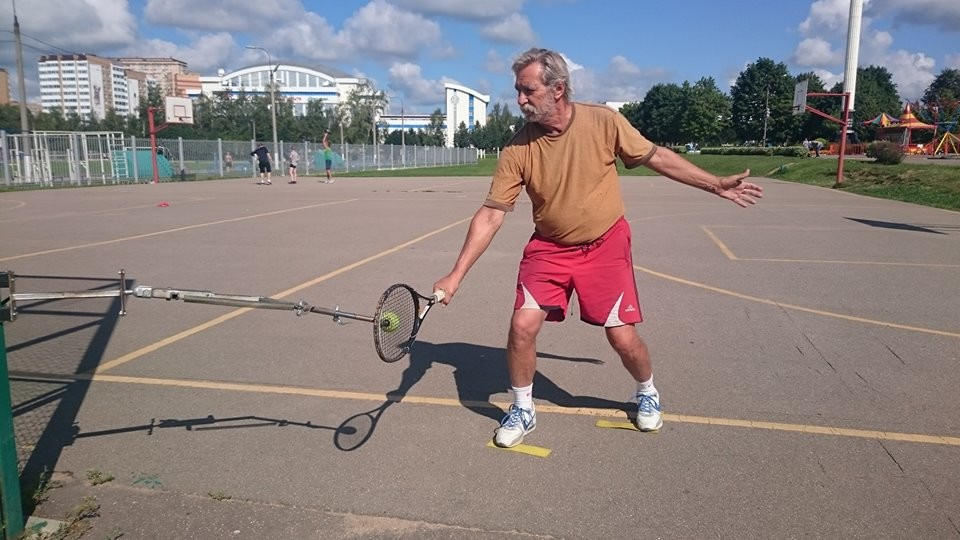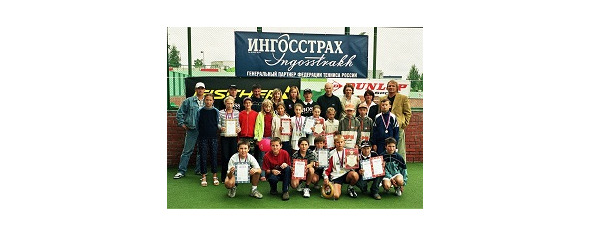
Бесплатный фрагмент - Tennis Player Physical Training Guide
Power is added only by the use of force
ANNOTATION
Knowledge of the patterns of how strength, speed, agility and endurance are acquired will be useful to readers. Many people want to know why regular training on the court adds strength and speed to technical elements very slowly. The book also describes the role of the vestibular apparatus and how to overcome its resistance to learning. This phenomenon was not previously known to either coaches or physiologists. Vladimir Ivanov, 2019
The first five years of teaching a child to play tennis are grief and tears.
Coaches excel themselves in working on hitting technique and… at the decisive moments of a rally in a competition, a child hits the ball to a point well below the equator and the ball soars up above the net, becoming an easy prey for the opponent or flies out of bounds. The coach and parents are also out - in the game on the score, the "perfect" technique of blows, as coaches often state, falls apart. Why? We know and we can quickly deal with this.
Study what is in the book. This will help you recognize obvious shortcomings in your child's training, as well as correctly distribute his and your efforts for the constant growth of the skill of hitting and success in the game!
Many people want to know why regular training adds strength and speed to technical elements very slowly. The book describes the role of the vestibular apparatus and how to overcome its resistance to learning. This phenomenon was not previously known to either coaches or physiologists.
perfect. And it's not a joke! Would you like your child to learn how to play tennis quickly and well? At the age of 4-5, send him to a dance school. Swimming at 6 years old. At 7 years old - karate, kung fu or judo. If he starts learning to play tennis at the age of 8, by the age of 10 he will be a champion. For a long time.
In the photo, coach Ivanov Vladimir Ivanovich. Many people want to know why regular training adds strength and speed to technical elements very slowly. The book describes the role of the vestibular apparatus and how to overcome its resistance to learning. This phenomenon was not previously known to either coaches or physiologists.

Players Winning More Matches Without Wasting Time On Court. Winning tennis players don’t waste time on the court. These are the announcements in the international press. And they are true. All the necessary qualities to win matches — strength, speed, endurance, agility are usually developed outside the court. The world’s leading players and coaches are well aware of this. In our country, children from 5 — 6 years old are driven around the court without appropriate physical training up to 12 — 14 years old and …, 95% of them say goodbye to tennis with sadness, and often with hatred.
Another question - and he is the main one in children's tennis. Why do most children at the age of 12-14 refuse to continue training in tennis and almost never play amateur tennis in adulthood? Pictured is the 2003 Olympic reserve. None of them play today. Children leave tennis not because that the coaches did not teach them well enough, or they are not talented, or because their parents did not control their classes well. You will find the answer to this question by reading the book.

16 Olympic Hopes 2003. Has anyone seen them on the courts at the present time?
SOME AXIOMS TO KNOW BETTER AND UNDERSTAND THEIR MEANING IN TRAINING TENNIS PLAYERS
200 RUBLES IS EXPENSIVE? FOR READING (COPY). DRAIN HUNDREDS OF THOUSANDS ON THE COURTS. BUT STILL, BE AWARE THAT TRAINING AND PLAYING ON THE COURTS DO NOT DEVELOP THE MUSCULAR APPARATUS AS MUCH AS IT IS REQUIRED TO WIN AGAINST PHYSICALLY PREPARED OPPONENTS.
The strength of the muscle group (groups) occurs only with regular, repeated repetition of load exercises of these muscle groups, which require effort to perform. Power cannot be accumulated for the future. With the termination of the application of effort (regular), muscle strength is significantly reduced. This postulate alone is worth 10 times more than any tennis fitness monograph. What do non-professionals, necessarily, regularly train on the court before the competition? Resting. As a result, very often they fly out in the first round without having time to play out.
Without strength in the muscles, there is no speed in movement. But the speed of movement is not a derivative of force. High-speed movements are developed only by repeated repetitions of high-speed movements. High-speed movements do not generate muscle strength and remain unchanged with regular, systematic training or are lost when training is stopped. Therefore, training high-speed movements without prior strength training is not promising.
That is why we do not see (and indeed there are none) successes among those tennis players (including children who begin to learn the game from 5—6 years old) who spend a lot of time on the courts, but do not engage in special physical training. And, finally, if the child finishes training and does not feel tired, then he did not learn to play tennis, but went in for physical education! It is also important to know that children with whom specialists conduct classes in special physical training learn technique and play much faster than athletes. Questions will arise, what is special physical training and how to carry it out? Write in a personal viivanov2013@gmail.com or call +79266041818 One thing is absolutely clear and distinct — if a child from 6 to 9 years old is not engaged in special physical training, nothing good will come out.
Which exercises, their priority, the speed of the exercises are discussed in the following chapters.
Strength, speed, endurance in tennis.
A lot of misunderstandings arise from not knowing the basic laws of the physical development of the human body and, in particular, tennis players. That is why years of technical training without the accompaniment of general and special physical activities outside the court do not bring the athlete either new strength or the glory of victories. The easiest way to pay attention to this pattern is by tracking the performance of the game of outstanding tennis players with filigree technique, but at an “outrageous” age. In other words, only technical training and playing on the score do not add anything to the performance at the competition.
And the fact is that the loads on the muscular apparatus during the game, although they can be very high, but they cannot be regular and repeated enough in a given unit of time to stimulate an increase in strength.
Alas, if the trainer working with your child does not require the child to attend classes in general and special physical training, then he either did not pay attention to this phenomenon, or does not work for the result. And do not flatter yourself if your children jump and run for an hour during the so-called physical training. It’s good for health. For tennis, no way. In order for a child to attend classes in general and special physical training, he either did not pay attention to this phenomenon, or does not work for the result.
And do not flatter yourself if your children jump and run for an hour during the so-called physical training. It’s good for health. For tennis, no way. In order for a child to attend classes in general and special physical training, he either did not pay attention to this phenomenon, or does not work for the result. And do not flatter yourself if your children jump and run for an hour during the so-called physical training. It’s good for health. For tennis, no way.
Laws of increase and preservation of force.
Remember - without strength in the muscles there is not and cannot be speed and endurance. so. To begin with, muscle strength can be increased, but without training it cannot be maintained. The acquisition of strength requires regular and constant overload on muscle groups. But if the loads are reduced or classes are stopped, then the athlete will lose 15-20% within 2-3 weeks, and up to 30% of strength within one and a half or two months. In athletes, strength is restored quite quickly (three times faster than it is developed), but only when strength training is resumed, and not in one day. It takes about a week of regular loads.
Do beginner tennis players need physical training?
This question requires an answer and, perhaps, clarification, since the parents of novice tennis players, for the most part, are well aware that this sport is very labor-intensive. However, many of those who understand believe that time spent on the court with a coach in group or individual training is enough to develop the necessary physical capabilities for success in competitions. And how sad it is to see the offended faces of parents whose children do not win and, despite the efforts of the coaches, will not win for a very long time.
To those who are not privy to the details of a tennis player's skill, it may seem that their child plays no worse than his rivals, whom he constantly loses to and they have to make unjustified conclusions. The child is constantly unlucky or… he is not talented enough. And this disastrous, but completely false postulate passed from mouth to mouth, inspired by negligent coaches about the need for special talent, destroys all hopes.
Below, it will become clear to most readers why the only true indicator of the so-called talent of a tennis player is his endurance. In this article, I will not touch on such qualities of an athlete as will, determination, perseverance and other often revealed signs of talent, which are necessary for a successful game, because if a child is not endowed with the power to produce speed and do it for quite a long time, then he realizes his talent in other disciplines, but not in tennis.
force. I believe that the subject of discussion will not be unambiguously clear if you do not give clear definitions to the concepts in the title. So what is power? In other words, how do you form a judgment about how strong or weak your child is? It is necessary to offer the child to do some physical exercises that do not require special technical skills. For example, jump from a place in length, up. Run a 30 meter race.
Pull up on the crossbar. Get off the floor. Strength is the ability to move one's body or weights equal to or greater than the body's weight. In order to imagine why a person, a child playing tennis, needs leg strength three times greater than the leg strength of a sprinter runner, it is enough to see that a tennis player constantly has to change directions of movement. At the same time, most often the change has the opposite, opposite direction.
Бесплатный фрагмент закончился.
Купите книгу, чтобы продолжить чтение.
